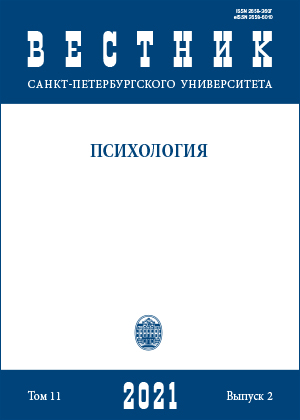Протективные и провокативные семейные факторы агрессивного поведения детей и подростков
DOI:
https://doi.org/10.21638/spbu16.2021.202Аннотация
В статье рассматриваются протективные и провокативные семейные факторы агрессивного поведения детей и подростков. Описывается негативное влияние агрессии на процесс социализации, а также возможные способы превентивного воздействия с целью нивелирования данного негативного влияния. В ходе анализа научной литературы, включающей эмпирические исследования семейных факторов и их влияния на проявление агрессивного поведения детей и подростков, были выделены два значимых кластера: 1) внутрисемейные социально-демографические факторы; 2) внутрисемейные психологические факторы и социальные установки. В рамках данной статьи были описаны психологические семейные факторы и социальные установки с точки зрения их протективного или провокативного влияния на проявление агрессивного поведения у детей и подростков, а также с точки зрения возможного профилактического и/или корректирующего воздействия на данные факторы. Частое проявление актов агрессии, а также высокий уровень агрессивности и враждебности детей и подростков относительно средних показателей их социума рассматривается как следствие отклонений в процессе социализации, в связи с чем обосновывается значимость комплексного подхода к профилактике и корректированию поведения детей и подростков из группы риска со стороны таких агентов социализации, как семья и школа. Также рассматриваются актуальные примеры комплексного профилактического воздействия на личность учащегося с помощью позитивных психологических интервенций (ППИ) на примере зарубежного опыта их применения. Кроме того, обосновывается необходимость согласованного взаимодействия института семьи и образовательного учреждения для эффективного положительного воздействия на процессы социализации в целом, а также профилактики и/или коррекции агрессивного поведения несовершеннолетних в частности.
Ключевые слова:
агрессия несовершеннолетних, агрессивность, социализация, семейная система, профилактика агрессии, позитивные психологические интервенции
Скачивания
Библиографические ссылки
References
Hazler, R. J. (1996). Breaking the cycle of violence: Interventions for bullying and victimization. London, Taylor & Francis.
Загрузки
Опубликован
Как цитировать
Выпуск
Раздел
Лицензия
Статьи журнала «Вестник Санкт-Петербургского университета. Психология» находятся в открытом доступе и распространяются в соответствии с условиями Лицензионного Договора с Санкт-Петербургским государственным университетом, который бесплатно предоставляет авторам неограниченное распространение и самостоятельное архивирование.




